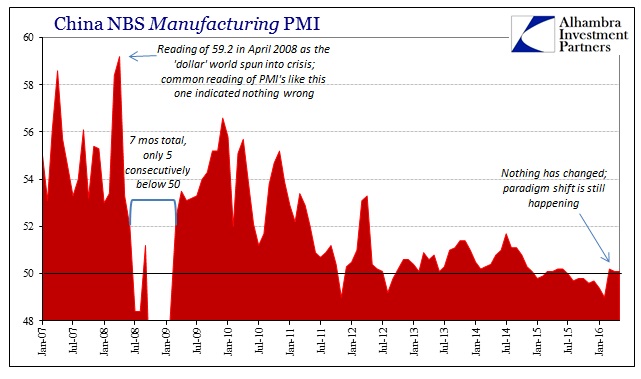China’s official manufacturing PMI was unchanged at 50.1 in May. As such, the media doesn’t know what to make of it. It’s slightly less than the 50.2 “rebound” in March, but still more than the drastic low of 49 in February. Because the index value is above 50, commentary is generally of cautious optimism.
We have seen this before, several times. China’s manufacturing PMI “unexpectedly” fell below 50 in January and February 2015, only to similarly “rebound” to 50.1 in both March and April, and then 50.2 in May and June. The narrative then was as it is now, one of guarded confidence that though the PMI wasn’t rising quickly it was at least on the good side of 50. We know what happened shortly thereafter.
The focus on 50 or not 50 is entirely misplaced; something that bears constant repetition. The ups and downs at the start of 2015 did not indicate a material change in the overall economic trend in China, so the shift from less than 50 to above 50 didn’t indicate anything other than that March and April 2015 were likely somewhat better than January and February; “better” being the operative term. Not quite bad as bad doesn’t equal good no matter which side of 50 the index falls.
What we see of 2016 has only reinforced the relativity that is sentiment surveys. January and the first part of February this year were subject to intense financial disruption in China more so than perhaps anywhere else. There can be no doubt that that created a direct economic effect of at least delaying some activities that would take place no matter what. Once the liquidations were ended (by the “dollar” hand of the PBOC), those projects could resume. The result was only that March and perhaps some of April was not nearly as bad as January and February, but overall not a meaningful change in overall condition.

Expecting the jump in March to be anything other than that was a (continued) fundamental misreading of the PMI data (or any other).











Leave A Comment